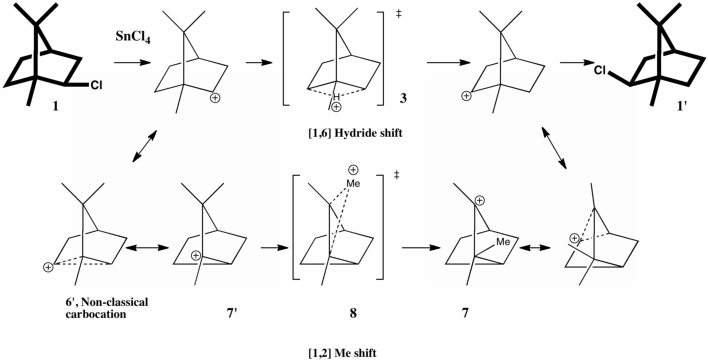
The scheme below illustrates one of the iconic reactions in organic chemistry.

The scheme below illustrates one of the iconic reactions in organic chemistry.
After around 40 posts here, I decided to take a look at the whole effort and ask some questions. For example Should (scientific) blogs be used to report new science, or merely opinion on existing science (see this blog also)? If the former, should they be abstracted in the manner of regular articles (e.g. by CAS etc). Unlike e.g. a journal, a blog is often (and certainly in this case) the effort of an individual.

In the previous post, the molecule F3S-C≡SF3 was found to exhibit a valence bond isomerism, one of the S-C bonds being single, the other triple, and with a large barrier (~31 kcal/mol, ν 284i cm-1) to interconversion of the two valence-bond forms.

A previous post posed the question; during the transformation of one molecule to another, what is the maximum number of electron pairs that can simultaneously move either to or from any one atom-pair bond as part of the reaction?

Clar islands are found not so much in an ocean, but in a type of molecule known as polycyclic aromatic hydrocarbons (PAH). One member of this class, graphene, is attracting a lot of attention recently as a potential material for use in computer chips.

In the previous two posts, a strategy for tuning the nature of the CS bond in the molecule HO-S≡C-H was developed, based largely on the lone pair of electrons identified on the carbon atom. By replacing the HO group by one with greater σ-electron withdrawing propensity, the stereo-electronic effect between the O-S bond and the carbon lone pair was enhanced, and in the process, the SC bond was strengthened.

In my first post on this theme, an ELF (Electron localization function) analysis of the bonding in the molecule HO-S≡C-H (DOI: 10.1002/anie.200903969) was presented. This analysis identified a lone pair of electrons localized on the carbon (integrating in fact to almost exactly 2.0) in addition to electrons in the CC region.

Steve Bachrach has just blogged on a recent article (DOI: 10.1002/anie.200903969) claiming the isolation of a compound with a C≡S triple bond; A compound with a C≡S triple bond Steve notes that Schreiner and co claim a “structure with a rather strong CS double bond or a weak triple bond”. With this size of molecule, the proverbial kitchen sink can be thrown at the analysis of the bonding.

The Grignard reaction is encountered early on in most chemistry courses, and most labs include the preparation of this reagent, typically by the following reaction: 2PhBr + 2Mg → 2PhMgBr ↔ MgBr 2 + Ph 2 Mg The reagent itself exists as part of an equilibrium, named after Schlenk, in which a significant concentration of a dialkyl or diarylmagnesium species is formed.

The so-called Fine tuned model of the universe asserts that any small change in several of the dimensionless fundamental physical constants would make the universe radically different (and hence one in which life as we know it could not exist). I suggest here that there may be molecules which epitomize the same principle in chemistry. Consider for example dimethyl formamide.